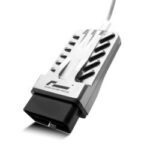Removing dents from your car can seem daunting, but with the right tools and techniques, it can be a manageable task. Whether you’re a seasoned professional or a weekend warrior tackling a DIY project, understanding the variety of dent removal tools available is crucial for a successful repair. This guide will explore the essential tools for car dent removal, from basic hand tools to advanced dent pulling systems.
Essential Tools for DIY and Professional Dent Repair
Addressing dents, scratches, and other blemishes on your car requires specific tools and techniques depending on the severity of the damage. A simple hammer won’t suffice for every situation. Let’s delve into the various tools available for different types of dent repair:
Basic Hand Tools for Minor Dents
For minor dents and dings, you might be able to get away with using basic hand tools like:
- Hammer and Dolly: This classic combination is used to gently tap out dents from the inside of the panel. A dolly provides a backing surface to prevent further damage. This method requires skill and patience to avoid creating additional imperfections.
- Body Filler and Spreader: Minor dents and imperfections can be filled with body filler (often referred to as “Bondo”). A spreader is used to apply the filler evenly and smoothly. Sanding and priming are required after the filler dries to achieve a seamless finish.
 alt text: Body filler and spreader being used to repair a dent in a car.
alt text: Body filler and spreader being used to repair a dent in a car.
Advanced Tools for More Serious Damage
Larger or more complex dents often require specialized tools:
- Stud Welder Dent Puller Kit: This kit uses a stud welder to attach pins to the dent, allowing you to pull it out with a slide hammer. This method is effective for pulling out dents without requiring access to the back of the panel.
- Dent Pulling System: These systems utilize various attachments like suction cups or glue tabs to pull out dents. They often come with different sized pulling heads to accommodate various dent sizes and shapes.
- Panel Shaping Kits: For restoring the original contours of a damaged panel, panel shaping kits offer specialized hammers and dollies designed for precise metal shaping.
Paintless Dent Repair (PDR) Kits
PDR is a technique for removing minor dents without requiring repainting. These kits utilize specialized tools like:
- PDR Rods: These rods are inserted behind the dent and used to gently massage the metal back into its original shape.
- Glue Pullers: Glue tabs are attached to the dent and then pulled out using a specialized tool. This method is particularly effective for small dents and dings.
- Tap Down Tools: Small, pointed tools used to tap down high spots or crown areas surrounding a dent.
Beyond these core tools, professionals often employ additional equipment like specialized lighting to identify subtle imperfections and air compressors to power pneumatic tools.
Choosing the Right Tools for the Job
Selecting the appropriate tools depends on your skill level and the extent of the damage. Simple hand tools might suffice for minor DIY repairs, while professionals often rely on advanced systems for complex restorations.
Remember, bodywork requires precision and patience. Practicing on scrap panels before tackling your car is highly recommended.
Conclusion: Achieving Professional Results
Whether you’re a professional auto body technician or a DIY enthusiast, having the right tools for dent removal is essential. From basic hammer and dolly sets to sophisticated PDR kits, understanding the function and application of each tool will enable you to achieve professional-looking results. Auto Body Toolmart offers a comprehensive selection of dent repair tools to equip you for any project, ensuring you can restore your car’s appearance to its former glory.

